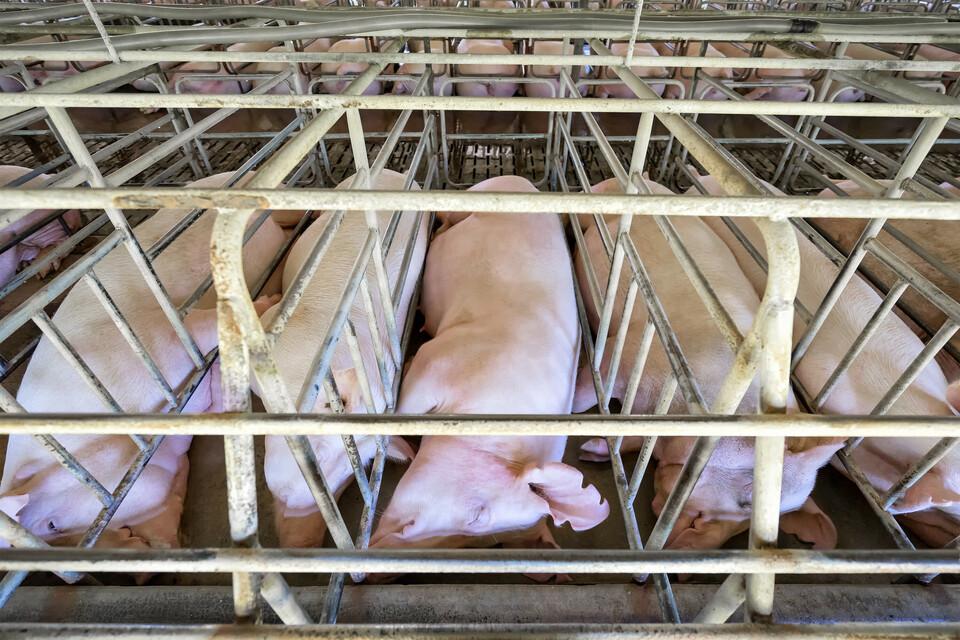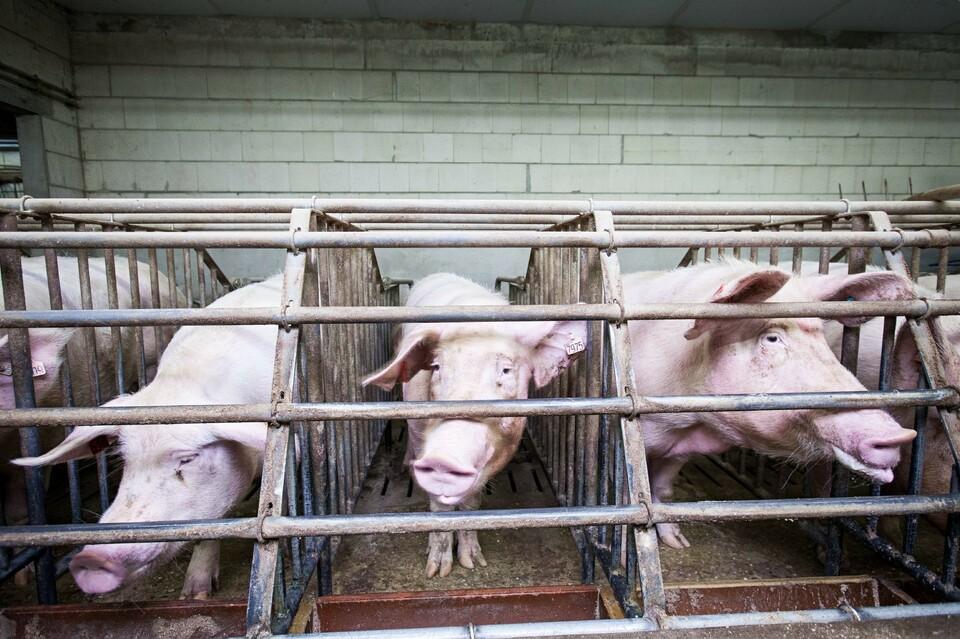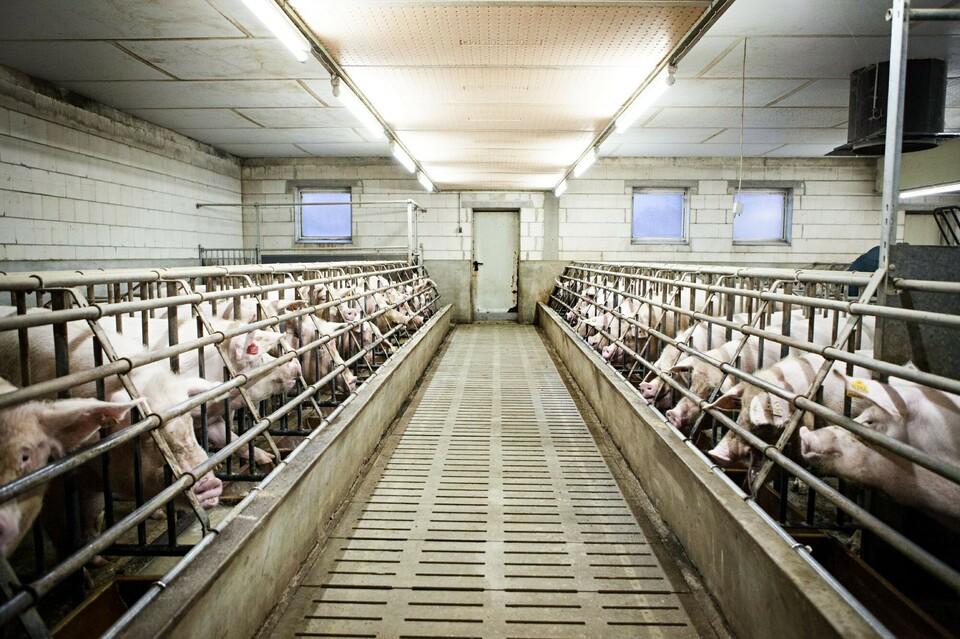
Sow crates
How the livestock industry treats breeding sows
Sows that are staying in conventional pig farms, spend about half of their lives in tight-fitting metal cages. These crates (farrowing crates and gestation crates) are justified by the industry by supposedly preventing the sow from accidentally crushing the piglets after giving birth. But the real reason is economy – producing as many pigs as possible in the shortest possible time, in the smallest possible space. Sows are not able to move or turn around in these cages. Nest building and social bonding with their piglets is not possible and the sows are forced to lie on hard, concrete floor and in their own faeces.
The problem
A sow is confined in a crate 10 weeks in a row – in farrowing crates for 1 week before and 4 weeks after giving birth, along with 5 weeks of confinement during and after insemination in individual gestation crates. Farrowing crates prevent the sow from forming a bond with her piglets – whose behaviour is also severely restricted in this kind of a barren environment2. The concrete floor is not littered, the sow is forced to lie on very hard floor, often leading to severe joint inflammations. The metal rods often cause purulent inflammation of the sows’ shoulders. She is forced to lie in her excrements which is not only unhygienic during giving birth, but also severely uncomfortable for the otherwise very clean individuals. The piglets are often trapped in the concrete slats as their feet are very small and the slats are often too big. A few days before giving birth, sows feel a strong urge to build a nest and would use twigs and grass in nature, but the need would also be satisfied by using straw. However, not only they aren't provided with straw, they do not even have the appropriate space to build such a nest, leaving them frustrated and stressed as their natural needs are not met1.
A sad, repeating cycle
Mother sows are treated like childbearing machines. Their life is an uninterrupted cycle of artificial insemination, pregnancy, farrowing, nursing time and then renewed insemination. A sow can get pregnant two or even three times in a year, with a pregnancy lasting about 114 days, followed by 3-5 weeks of nursing time3. In the EU most of piglets are weaned at an age of 21 or 28 days as per EU legislation, but EU organic farms legislation provides a minimum weaning age of at least 40 days. Some farms outside of the EU practice early weaning of piglets, allowing only as little as 10 days of nursing4. The problem of weaning before 40 days is actually that the immune system of the piglets is not fully established. The ideal mother-child-bond can only be established if the sow does not have more piglets than teats, which is often not the case in modern breeds that are bred to produce as many piglets as possible, more than the sow can care for. This leads to high numbers of underweight piglets that are usually killed on-farm.
Inseminated at 5-7 months
The young females are inseminated for the first time at around five to seven months. To do this, she is locked in a crate in the 'breeding centre'. The heat (phase of receptivity) is brought about by hormone injection or more naturally, by being in proximity to boar pheromones. This way the sow can be inseminated artificially at a specific time point that suits the management of the farm. Usually, farmers want to synchronise a whole group of sows, so that they can move all of them to a different compartment in their rotating cycle and all production stages are occupied evenly. Once the sows are inseminated, they are usually put in individual gestation stalls, where they stay for at least four to five weeks, supposedly to preserve the pregnancy. But in reality, it is all about economy and the reckless, cost-efficient way of production. Once the weeks of isolation pass, they are released back to the group, until one week before the farrowing starts.
Giving birth and suckling in extremely tight spaces
The sow is then brought to the farrowing pen about a week before the calculated date of birth. There she is crammed into a metal cage for about 5 weeks (a crate in the farrowing pen) in which she gives birth to about 10-20 piglets, and which she nurses for about three to four weeks in most farms, or even less if the farm practices early weaning. In a natural setting, a week after farrowing, the sow would start to introduce her piglets to the herd, then nurse them for about 15 weeks, while socialising with the herd the rest of the time.
The bars in the farrowing crate separate the mother from her piglets. The piglets can reach the teats of the mother under the rods, but the mother cannot make loving contact with her piglets. After piglets are weaned, the sow is usually almost immediately returned to the breeding centre and back to the insemination crate. It is only during her pregnancy, that she is kept in the group with other (pregnant) sows for a few weeks.
Sows give birth until death
A sow goes through this production cycle until it no longer achieves the desired 'reproductive performance' of an average of about 30 piglets per year. Then she is slaughtered. Most sows only survive this cycle for just a few years. The natural life expectancy of pigs would be much higher.
Legal situation in Europe regarding farrowing crates
Numerous European countries have already banned the crates in some ways – some in the deck area (e.g. the UK), some in the farrowing area, and some even both. For example, Sweden and Norway have a ban on both, with Swedish studies reporting that there is no higher loss of piglets in farrowing pens without crates.
The farrowing crate has been banned in Switzerland for some time. In 1977, a ban on farrowing crates was decided, and in 2007 the transition periods had expired. Sows in Switzerland are not allowed to be kept in farrowing crates but are still allowed to be kept in gestation crates for a maximum of ten days.
Austria has also already banned crating of sows in 2013, but with a transition period of 20 years. Currently, breeding sows can be kept in crates for a maximum of 206 days per year; however, in newly built, converted, or first-time stables, pigs can be kept in crates for a maximum of ten days.
In Germany, sows can be kept in crates for about 10 weeks at a time – for several times a year. One week before the expected farrowing date, during the birth and during the entire suckling period until four weeks after the next insemination. The German legislation had been changed in 2020. Since 1988 the German legislation stated that pigs lying on their side must be able to stretch their limbs freely, but this was ignored for decades. In 2015, a court decision recognised that the sow crates in use were illegal. Instead of finally ensuring that the legislation is complied with and that the stables are finally converted for the better for the animals, the Ministry of Agriculture had ensured that the decisive paragraph requiring the stretching of limbs was deleted from the regulation. In this way, it is still allowed to keep sows in gestation crates until 2030 and in farrowing crates until 2037.
The use of sow crates is overall the standard in most countries. Due to public concerns, some indoor group farrowing systems have been developed but are not being used to any significant extent in commercial practice and most sows remain restricted to the crate throughout most of their lives5.
Public perception
As more people are becoming aware of the cruelty of farrowing crates, the public pressured many food companies across the globe to promise to push back against farrowing crates that are in use for the production of their meat. Between 2012 and 2015, more than 200 food companies, including restaurant chains like McDonald's, Burger King and Wendy's have surrendered to the consumer demand for more welfare-friendly production6. Most of these companies are expecting to hit their target of crate-free production by 2022, with some already making good on their promise in their EU bases7.
Source
2) https://thepigsite.com/articles/practical-options-for-indoor-freefarrowing-systems
3) http://www.nzdl.org/gsdlmod?e=d-00000-00---off-0hdl--00-0----0-10-0---0---0direct-10---4-------0-1l--11-en-50---20-about---00-0-1-00-0--4----0-0-11-10-0utfZz-8-00&cl=CL1.14&d=HASH012fbc1291f9d347cee97f25.5.1>=1
4) https://thepigsite.com/articles/basic-pig-husbandry-the-weaner
5) https://eur-lex.europa.eu/legal-content/EN/TXT/HTML/?uri=CELEX:52001DC0020&qid=1596615262106&from=EN
6) https://civileats.com/2018/03/21/after-a-decade-of-promises-has-the-food-industry-made-progress-on-gestation-crates/
7) https://corporate.mcdonalds.com/corpmcd/scale-for-good/our-food/animal-health-and-welfare.html





